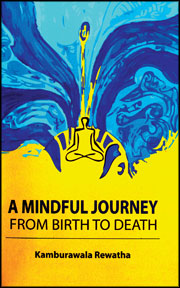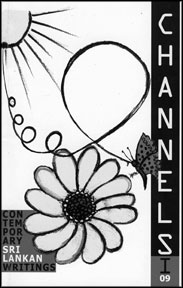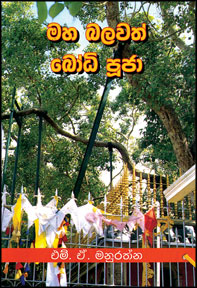|

Be aware of what you do
Reviewed by R. S. Karunaratne
 According to traditional Buddhist texts mindfulness or Satipattana
means paying attention to the things that you do. There are four
foundations of mindfulness: Contemplating on the body (Kayanupassana),
Contemplating on the feelings (Vedananupassana), Contemplating on the
mind (Cittanupassana) and Contemplating on mental phenomena (Dhammanupassana). According to traditional Buddhist texts mindfulness or Satipattana
means paying attention to the things that you do. There are four
foundations of mindfulness: Contemplating on the body (Kayanupassana),
Contemplating on the feelings (Vedananupassana), Contemplating on the
mind (Cittanupassana) and Contemplating on mental phenomena (Dhammanupassana).
These four foundations of mindfulness are developed by all Buddhist
practitioners. Kayanupassana is the most common meditation practice.In
mindful breathing you become aware of the entire process of breathing in
and breathing out while keeping your body in the correct posture.
The author has described in detail how it can be practised while
walking, lying down, eating, drinking, using the bathroom or speaking.
Mindfulness can be practised towards internal aspects and the 32
parts of the body and also nine cemetery aspects. This is done by
looking at a dead body in relation to one's own mortality and
impermanence.
However, these are reserved only for monks.
The practice of mindfulness by looking at a dead body has given rise
to the myth that Buddhism is all about death. This is evident from the
other practices of mindfulness which help us to maintain our sanity and
happiness. For instance, when you practise mindfulness of feelings, you
become aware of your pleasant feelings. You also experience painful
feelings when you undergo an unpleasant situation.
Mindfulness of consciousness is important in that the meditator knows
that when the consciousness is filled with lust. This applies to other
experiences such as ignorance, hatred, or restlessness. When there is
mindfulness of consciousness, one does not know that one is ignorant.
According to the author, mindfulness of mental phenomenon is the
final foundation. Anger, sleepiness, laziness, agitation, worry and
doubt form part of mental phenomenon. Monks who practise meditation know
when they experience a sense of desire or absence of desire.
The book encourages Buddhists to follow the Noble Eightfold Path to
overcome suffering. The Sammasathi is the seventh path which leads to
Nibbana.
Without developing Sammasathi we cannot develop Samadhi or
Concentration. In fact, Buddhism is based on Sila, Samadhi, Panna
meaning Morality, Concentration, and Wisdom. Thus, mindfulness is one of
the main elements of the Noble Eightfold Path.
The author points out that people practise mindfulness in a
non-religious context without paying attention to Samadhi or Wisdom.
Mindfulness skills are used as tools to navigate the mind to free it
from stress. This is very much evident in the affluent West where people
undergo a lot of stress. Therefore, mindfulness should be practised
meaningfully preferably under the guidance of a teacher.
Making a comparison between the practices in the East and the West
the author comes to the conclusion that the modern approach to
mindfulness meditation in a non-religious context is mainly designed to
reduce stress and prevent further depressive relapses. Although Buddhist
mindfulness practices are similar, their final goal is to uproot mental
and physical suffering. This is clearly explained in Satipattana Sutta.
According to Buddhism one who practises the four foundations of
mindfulness will achieve one of the highest parts of enlightenment
within seven days, seven months or seven years.
Near-death experiences have drawn a lot of interest among both
Buddhists and non-Buddhists. The author says that some people experience
out of the body experiences due to a chemical process triggered in the
brain. He has cited many incidents to support his claim.I found the
chapter on euthanasia quite interesting. According to the author,
euthanasia is legal in certain countries such as Australia, Belgium, the
Netherlands and Thailand which is a Buddhist country. In these countries
euthanasia is viewed as an act of loving kindness.
However, there are countless anti-euthanasia activists all over the
world. For them, euthanasia is another form of suicide which goes
against morality and religion.
The Buddhist point of view is very clear on this matter.
Buddhism does not approve of euthanasia in any form because it is
tantamount to taking somebody's life.
Taken as a whole, A mindful journey from birth to death is a useful
addition to Buddhist literature. It broadens the horizon of our
knowledge in no small measure.
Glimpse into contemporary Sri Lankan writings in English
by Indeewara THILAKARATHNE
 Channels, the latest volume of writings by English Writers
Cooperative of Sri Lanka, apart from its literary value, offers insights
into the literary landscape of English Writings in Sri Lanka. Channels, the latest volume of writings by English Writers
Cooperative of Sri Lanka, apart from its literary value, offers insights
into the literary landscape of English Writings in Sri Lanka.
Over the years, Sri Lankan literature in English has been growing
both in terms of quality and quantity. For the latest volume, 68 entries
have been selected. The anthology includes both poetry and short
stories. One of the important aspects of the writings in Channels is
that it contains writings on a variety of subjects ranging from
experiences in exile, impressions from first person's perspective and to
the reflections of poverty and war.
In the short story 'Samanmali' by Hasini Apsara Haputhanthri, the
writer portrays a vividly realised character of Samanmali drawing
parallels with the life in Sri Lanka and the student's life in a
cosmopolitan university in the UK. The short story, which won the first
place in the short story competition conducted by the English Writers
Cooperative of Sri Lanka, is not a mere account of a girl who flies to
the UK for higher studies and a description of student life in a
university city in the UK but also a sharp social criticism on the
diverse mindsets here in Sri Lanka and in the UK.
"As I stand I see them as men and women, I also see them as white,
intensely aware of my brownness, when they look at me I try to sense
what they see in me. Then, I also see them as artists: the way they
measure my body to the proportion of their pencils; the keenness,
appreciation and dispassion in their eyes; the way they step back and
look at their work after two hours of concentration and fall in love
with it, yet not with me. There was a short of madness in them that
healed me." The author masterly portrays the mindscape of the students
who see Samanmali as a model. In a strange way nudity has shed her
personality; for the students, she is only a naked model. They treat her
objectively. Towards the end of the story, the writer states that though
the name 'Samanmali' is an ill-fitting garment, the character still
wears it. The writer in a most subtle and effective manner, highlights
the folly of intransigent mindsets and perceptions, sometimes, formed
based on ill-conceived notion such as one's name which is often
associated with the personality of the person who bears that name.
The poem 'Fatherland, motherland and other Land' by Basil Fernando,
questions widely held perceptions such as those of motherland,
fatherland and heroes. It is a sharp criticism on the ideology of war.
The poet questions the notion that history creates heroes and then asks
who creates history.
"Grateful nations kill their heroes
And sing their praises
When madness reigns
Heroes live in coffins"
The poem is an indictment against conflict. However, the poet
maintains objectivity so that the poem can be universally applicable in
the context of conflict. The poem , among other features, is marked for
its brevity of expression and inverting widespread perceptions
associated with key words such as fatherland, motherland and heroes to
convey an oppositional view. Other poems on the similar themes are "Life
Goes On "by Chithra Premaratne-Stuiver and "To post a Letter" by Shireen
Senadhira.
Through a common place scenario of posting a letter, Shireen
Senadhira portrays a picture of a ghost town with an abandoned post
office in a remote hamlet of the country.
"I clutched the envelope crushed
My black ink strokes hover intensely still
Even remote hamlets are
Affected by this wonton war
The empty school house stand forlorn
Struck pink by an evening sun
I remember school children tumbling out joyously"
It is the contrasting images of happy days when schools are occupied
by joyous children, which juxtapose with eerily vacant landscape that
drive home destructive nature of war which is now a thing of the past.
In the short story, "Playing with fire", Neluka Silva stresses the
danger of having extra-marital affairs. She has particularly used
techniques of flashback effectively and making the victim the narrator
of the story. Neluka's short story is one of the effective short stories
in the anthology.
In the poem "The Girl from the Ditch", Sakuntala Mohini
Sachithanandan portrays a picture of an impoverished community in the up
country plantations. M.T.M Ebell's poem 'Door' describes the story of a
door. Though simple in diction, Ebell has personified 'door' and the
story is told from 'door's perspective. In the poem 'Iconic Bodies',
Jean Arasanayagam offers a critical view of the female body.
"I feel this curious sense of nakedness
Clothing me, now devoid of costumed artifice
That created our females ....
Women's bodies becoming the literature
Of poetic imagination carried in the back-
Packs of literary travellers migrating from
One epoch to another"
The poet states that whether these decorative embellishments had
actually changed the women's bodies and their textures or 'Lives
otherwise prosaic or mundane'. In a way, the poem is critical of widely
held perceptions of women and those created in literature which carry
from one epoch to another. The poet wants to emerge from the prototype
perception of women.
'The path', a short story by Ayathurai Santhan, revisits pre-conflict
Jaffna. The story unfolds with a person cycling along a path. In the
course of the description of the path, the author has revisited the
pre-conflict Jaffna and the painful changes brought upon the people who
lived on this path.
In 'A Silver of Spice to life', Nanda Pethiyagoda narrates a story
which could have happened in a rural hamlet. The poem "In memoriam"
Chamali Kariyawasam poignantly recalls the fallen heroes who have made
the supreme sacrificed for the motherland. The poet states that the
proud lion flag unfurls as 'heroes come, bearing the wounded'.
'So sweet this blood
On the land we call home;
Bitter the sound of
Tears drip dropping"
In the short story 'The post man', Anthea Senaratna turns rather a
common experience into collective experience when she recalled that post
man's presence has become a part of her routine. Following the transfer
of the post man, the author realised that something was missing in her
life. Dushy Parakrama's "Break up", though very brief, has captured the
emotional state of a woman who has just after break-up with her husband.
The Channel, among other things, offers an overview of Sri Lankan
contemporary writings in English. It is noteworthy that over the years,
Sri Lankan writers in English have devised language and idiom in English
which is capable of expressing authentic Sri Lankan life experiences in
English with a remarkable degree of clarity.
A handbook of Buddhism
 Maha Balawath Bodhi Pooja Maha Balawath Bodhi Pooja
M.A. Manurathna
Price: Rs. 325
Sridevi Printers PVT Ltd, Papiliyana
Conducting Bodhi Pooja has been a popular religious practice of
Buddhists throughout the years. In his latest book 'Maha Balawath Bodhi
Pooja', Manurathna elaborates on the effect of conducting a bodhi pooja.
He also gives in detail the correct way of doing it.
The book also contains Buddhist Gathas and Suttas such as Karaneeya
Meththa Sutta and Maha Mangala Sutta.The writer has written several
books on Buddhism. Manurathna who holds B.A. (Special) and a Post
Graduate Diploma is also the Registrar of Pasdunrata National College of
Education, Kalutara.
Book launch:
 'Mema Hera Liyo' 'Mema Hera Liyo'
By Tharanga Ranasinghe
Godage Publication
'Mema Hera Liyo' a collection of short stories written by Tharanga
Ranasinghe, will be launched on August 18 at 3.30 pm at Library Services
Board Auditorium. Tharanga, a teacher and a Journalist by profession,
had published two other collections of short stories and Poems, earlier.
Prominent writer Sunethra Rajakarunanayaka, novelist and critic Dr.
Liyanage Amerakeerthi and critic Chinthaka Ranasingha will deliver
speeches on short story and Tharanga's contribution to literature. 'Mema
Hera Liyo' is a Godage Publication.
|

